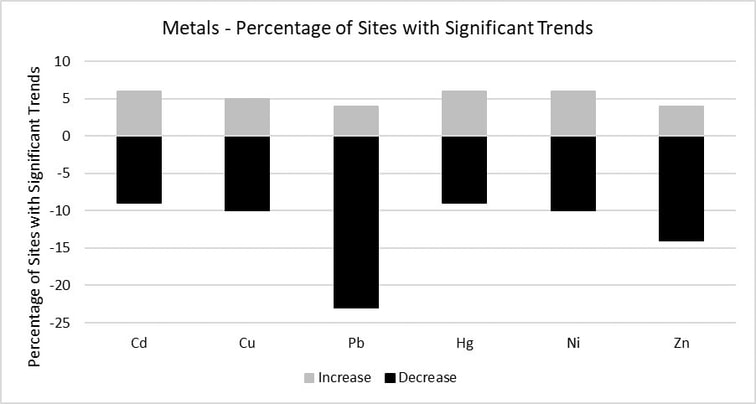The term “heavy metals” covers a wide range of elements on the periodic table, and there is no widely agreed-upon definition for the term. Most trace metals measured as part of environmental monitoring efforts are naturally occurring, and many are essential as nutrients, but all metals can be toxic at high concentrations. Elevated sediment concentrations can be indicators of metal contamination released into the environment by human activity. Sources such as wastewater effluent, atmospheric deposition, urban runoff, and copper-based agricultural products all contribute to trace metal concentrations in sediments.
SPoT currently measures nine trace metals: arsenic, cadmium, chromium, copper, lead, manganese, nickel, silver and zinc. There are established toxicity thresholds (H. azteca and C. dilutus LC50s) for arsenic, cadmium, copper and nickel, but no individual metal concentration exceeds these metal LC50s. Copper and nickel concentrations at some sites amount to approximately one-half a TU, but there is no significant relationship between any of the individual metals and observed toxicity.
Calculated trends for cadmium (Cd), copper (Cu), lead (Pb), mercury (Hg), nickel (Ni) and zinc (Zn) from 2008 to 2020.
SPoT currently measures nine trace metals: arsenic, cadmium, chromium, copper, lead, manganese, nickel, silver and zinc. There are established toxicity thresholds (H. azteca and C. dilutus LC50s) for arsenic, cadmium, copper and nickel, but no individual metal concentration exceeds these metal LC50s. Copper and nickel concentrations at some sites amount to approximately one-half a TU, but there is no significant relationship between any of the individual metals and observed toxicity.
Calculated trends for cadmium (Cd), copper (Cu), lead (Pb), mercury (Hg), nickel (Ni) and zinc (Zn) from 2008 to 2020.

